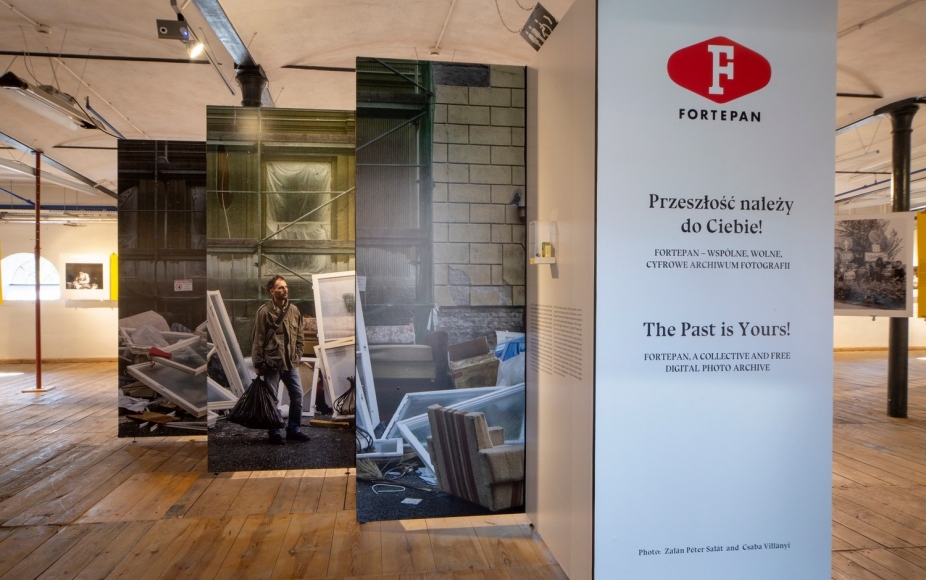Interior photos by Łukasz Szeląg
---
The Past is Yours!
Fortepan, a collective and free digital photo archive
August 6 – 23, 2020
Fabryka Sztuki, Fotofestiwal (Łódź, Poland)
The 130,000 photos in the Fortepan digital archive began to be collected by two Hungarian high school classmates, Miklós Tamási and Ákos Szepessy, at junk clearances and flea markets in the 1980s in Budapest, Hungary. After several decades of collecting old photographs on a regular, if occasional, basis, the two enthusiasts launched their online archive with five thousand pictures ten years ago, in 2010. Soon many private individuals and – more recently – public institutions joined the circle of donors, which now numbers almost seven hundred. The prints and negatives supplied by the donors expand the photo archive each month by cca. 1-2000 photographs.
The evolution of the Fortepan archive, that collects photographs only from before 1990, is closely linked with twentieth-century Hungarian history, with the development of analogue photography, with the collection and publication of photographs, with amateur photography, and with many other factors. Yet there are perhaps two core notions underlying the essence and uniqueness of the project: free and collective.
Collective – because the archive is made up of our pictures. Collective – because it is based on the work of volunteers. Collective – because we too can assist in identifying people and locations in the pictures. Collective – because the archive is not bound by language and can thus be interpreted and reinterpreted without reference to national borders.
Free – because it is freely accessible to all, with no strings attached. Free – because there is no desire for possession; instead, Fortepan aims to give back. Free – because anyone can inspect the photos in great detail. Free – because it places trust in its donors, volunteers, “codebreakers”, and users.
Free, because it is collective. Collective, because it is free.
All this renders Fortepan a truly exciting initiative, potentially making a participant out of anyone of us. It can give people a sense of self-worth, proving them that their photos are important and can make a difference, and that they too can do something for the community. Moreover, the online archive promotes the survival of the photos submitted by donors and commemorates the people featured in the photos, thereby giving additional meaning to the exertion required when making and preserving photographs. It also provides and presents evidence, enhanced by the information and conclusions drawn from the common well of knowledge. It does so in such a way that the collective knowledge is then made fully accessible to everyone.
Albeit at different times of life, most of us have experienced or will experience a desire to search for our roots. This desire is integrally linked with the life stories of close family members, relatives, and friends, but also with the history of our country, our continent and the whole world. The hardest task is establishing a connection between micro- and macrohistory; it is here that Fortepan can serve as a bridge. The pictures in the Fortepan online archive can even substitute for those old family photos that were safely kept by the grandparents over long decades but then rashly discarded by a grandchild during a house move.
Hopefully a Polish Fortepan sister site is soon to be born...
By looking for our common past, the exhibition refreshes our memory with recollections of events that we may not have experienced ourselves but are linked in some way with us, or as Zsuzsa Rakovszky puts it in her poem inspired by Fortepan images: “every past is my past.”
---
CREDITS
Curator: István Virágvölgyi
Co-curator: Miklós Tamási
Project coordination: Franek Ammer, Małgorzata Słomska
Exhibition design: Zsófia Koczka
http://fotofestiwal.com/2020/en/exhibitions/miklos-tamasi-and-istvan-viragvolgyi-the-past-is-yours
the virtual version of the show can be found here: https://prezi.com/view/0dljh3FvDs5M72GYtRjI
Fortepan website: http://fortepan.hu
The exhibition was supported by the Wacław Felczak Foundation and the Hungarian–Polish Non-Governmental Cooperation Program.
